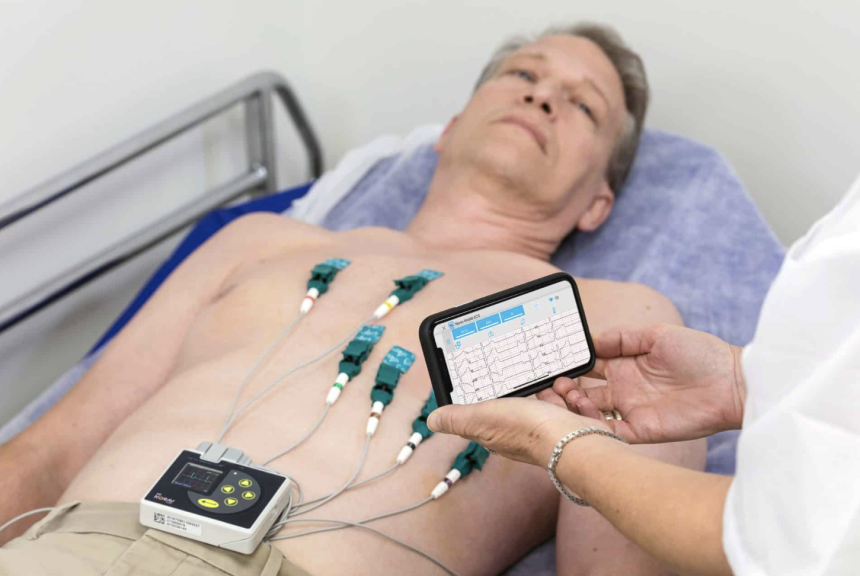An electrocardiograph, or ECG, is a machine for making a record of the electrical activity of the heart as surface potentials. Potentials are transferred to the ECG machine by metal electrodes at different body points, which are usually four limbs and the chest. The machine traces voltage differences between two electrodes simultaneously.
The normally occurring ECG tracing comprises P, Q, R, S, and T, incidental structures with each phase as an individual cardiac activity. Shape and pattern differ depending on where the electrodes are placed. Physicians can determine the likelihood of abnormality in the heart from a deviation of this normal pattern. When considering the price of an ECG machine, factors such as features, brand, and technology play a crucial role in determining cost.
Types of ECG Machines
1-Channel ECG Machine
A 1-channel ECG device records the electrical heart activity one lead at a time. It is the most affordable one and one that is common in primary care for basic cardiac examination. While as much as it can detect abnormal heart rhythm and heart attack symptoms, it might not be the best tool to use in detecting more complex heart conditions.
For example, if a patient is suffering from chest pain, a 1-channel ECG machine is utilized to immediately check if there’s any abnormality in the heart rhythm or symptoms of heart attack.
3-Channel ECG Machine
A 3-channel ECG monitor is a monitor of the heart’s electrical activity from three leads simultaneously. It is a broader test than a 1-channel ECG and is used to diagnose conditions like atrial fibrillation or ventricular hypertrophy. It is usually used in clinics for general monitoring of the heart. The Contec ECG machine is a popular choice for accurate and reliable heart monitoring, offering advanced features for medical professionals.
Example: In a patient’s history of heart disease, 3-channel ECG can detect the rhythm disturbances and provide a better idea about the functioning of the heart.
6-Channel ECG Machine
Since it has the capacity to record six leads simultaneously, a 6-channel ECG machine provides a more comprehensive representation of cardiac activity. It is widely used in hospitals and clinics for thorough cardiac assessments. This ECG is especially useful in the diagnosis of myocardial infarctions and bundle branch blocks.
Example: Where the patient is complaining of pain in the chest, a 6-channel ECG will give a more precise reading that can assist in detecting heart attacks and other lethal conditions.
12-Channel ECG Machine
The 12-channel ECG machine captures the cardiac electrical activity through twelve leads at the same time and provides the maximum extent of worldwide cardiac analysis. It is used widely in cardiac wards and hospitals for diagnosing complicated cardiovascular conditions like heart enlargement and ischemia.
Example: In a patient with cardiac history, 12-channel ECG is able to identify tiny faults in the rhythm of the heart and give a basic impression about the health of the heart.
Portable ECG Machines
Portable ECG devices are complemented by convenience use via heart monitoring beyond the traditional clinical setting. Portable, light, battery-operated, and off-site patient monitoring, home calls, and ambulatory, are compact machines. They provide continuous information under normal daily activity or time-limited events, which enables simple heart monitoring over time. Certain handheld ECG devices are wireless enabled to allow for immediate data transmission to medical professionals for quick diagnosis and treatment.
Essential Features of an ECG Machine
Lead Configuration – Comes in 1-channel, 3-channel, 6-channel, and 12-channel versions, the last of which can perform more sophisticated heart activity analysis.
High-Resolution Display – Clear LCD or touch screen to facilitate easier reading of waveforms.
Paper or Digital Recording – Thermal paper-based ECG readings are found on some models, while others record data digitally for later analysis.
Auto-Interpretation – More sophisticated models include computerized ECG analysis to aid in diagnosis.
Portability – Light-weight, battery-powered, and portable designs for simple mobile and off-site deployment.
Connectivity Options – USB, Bluetooth, or Wi-Fi connectivity for smooth information exchange with electronic medical records.
User-Friendly Interface – Simple controls to enable simple setup and optimal performance in healthcare facilities.
Data Storage and Retrieval – On-board storage or cloud storage to track patient history over time.
Safety and Reliability – Intrinsic protection against electrical interference and rugged construction for extended use.
Wireless Capability – Digital wireless ECGs reduce cable clutter and improve patient comfort.
Choosing the Right ECG Machine
- Different ECG machines help in faster diagnosis and treatment, allowing patients to monitor their heart health effectively.
- Regular clinic visits for ECGs can be time-consuming and expensive. Owning a reliable ECG machine reduces these hassles.
- ECG machines can identify heart irregularities, such as blockages and abnormal rhythms, preventing severe complications.
- Certain ECG machines enable doctors to assess heart health remotely, ensuring timely medical intervention.
ECG machines are essential for heart health monitoring, offering convenience, early detection, and remote access.
Lynn Martelli is an editor at Readability. She received her MFA in Creative Writing from Antioch University and has worked as an editor for over 10 years. Lynn has edited a wide variety of books, including fiction, non-fiction, memoirs, and more. In her free time, Lynn enjoys reading, writing, and spending time with her family and friends.















